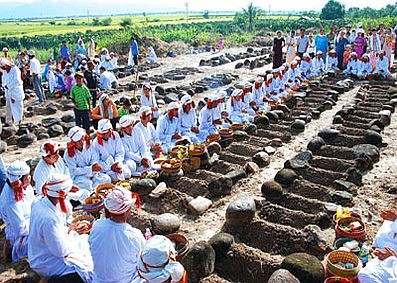(VOVworld) – The Cham Balamon and Cham Bani ethnic groups are matriarchal.
 |
| The Ramuwan festival of the Cham (Photo: baoninhthuan.com.vn) |
In Vietnam many ethnic groups are still matriarchal. The Ede women hold all the power in the family and the community. But the Gia Rai women are not allowed to enter the Rong communal houses, even though the Gia Rai ethnic group is also matriarchal. Cham matriarchy has some particularities. Le Duy Dai, Head of the Division of Culture Study and Collection of the Vietnam Museum of Ethnology, says Cham society is organized by the mothers’ clans: “The typical feature of Cham matriarchy is that children bear their mother’s family name. They live in groups;: sisters and their mother live together. The youngest daughter lives with her parents and inherits the biggest share of properties. The sons do not receive anything”.
Cham matriarchy is reflected vividly in marriage, where the bride’s family takes the initiative. Before a girl is grown up enough for marriage, her parents seek the best would-be groom for her among the local youths. The match-making and marriage proposal is undertaken secretly. A girl has the right to marry a boy and the groom must follow the girl’s arrangement and move to live into the girl’s house. These days a young couple can live separately, but they still follow the bride family’s lifestyle. When they die, Cham men are buried in the matriarchal clan’s cemetery.
 |
| Pottery making in Ninh Thuan (Photo: baoninhthuan.com.vn) |
Cham matriarchy is visible. In their famed craft of pottery making, Cham women perform the important steps, including shaping the clay, while men are involved in kneading the clay and baking the pottery. According to Cham myths, their pottery forefather Poklong Chanh only passed down his know-how to the Cham women. So, despite the demanding work, it is the Cham women who play the leading role in this traditional craft. But, says researcher Le Duy Dai, Cham men also have important role:“The Cham people have a saying which reflects their respect for men. Although wives are called the household chiefs, husbands have the right to make community decisions. The chief of a clan is a male, not a female”.
Chief monk Han Van Dau, in charge of the Po Inu Nuga pagoda in Ninh Thuan province, says the household work for men and women is clearly defined. Both husband and wife share responsibilities. Dau said: “The men are engaged in farm work. The women do housework. So both are responsible for their family, including bringing up their children. Unanimity between husband and wife can dry up the East Sea as the saying goes”.
Cham women are free from labor-intensive work. They are responsible for worshipping family ancestors at home, while men are engaged in worshipping rituals at pagodas. Chief monk Han Van Dau told VOV: “Actually, the worshipping rituals are led by men. They are also in charge of writing prayers. Thus, the men’s responsibility is heavier than the women’s. Women act in family financial matters as a treasurer”.
There is a Cham saying: “A man’s destiny is fighting. A woman’s destiny is giving birth”. The division of labor between men and women is clearly defined in Cham society.